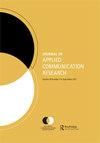应用传播研究中的“种族问题”:过去、现在和未来
IF 1.7
2区 文学
Q2 COMMUNICATION
引用次数: 6
摘要
自该学科成立以来,社会问题一直在促进传播学术的发展(Orbe & Allen, 2008)。从一开始,《应用传播研究杂志》(JACR)的重点一直是研究现场社会问题的传播研究(Hickson, 1973)。多年来,JACR一直倡导通过富有成效的理论框架为特定的基于沟通的问题提供实践指导的学术研究(Eadie, 1990)。2022年特刊延续了这一传统。具体来说,它旨在展示一个学术空间,突出应用传播研究,以有意义的深刻方式集中种族-并通过交叉性,身份的其他突出方面。因此,它的特点是从事研究,将种族集中作为理论锚和有力的实践点。“种族问题”作为一个意识形态概念,最早是由韦斯特(1993)提出的。这个短语深刻的双重性强调了种族的重要性(race作为名词,matters作为动词),以及与种族相关的话题多样性的广度(race作为形容词,matters作为复数名词)。考虑到这一点,“种族问题”是一个合适的标记,旨在参与种族的社会建设的特刊,特别是在种族主义的显著和深远影响继续在美国和全球社区表现出来。传播学并没有逃脱白人至上主义和种族主义的影响。虽然有色人种学者的批评已经记录了多年(例如Daniel, 1995年),但最近关于交流领域缺乏有色人种学者和学术代表的讨论已经达到了新的高度。这在一定程度上是由于一项分析发现,在整个传播领域,有色人种学者在发表率、被引用频率和编辑角色方面的代表性仍然严重不足(Chakravartty等人,2018)。这项研究——通过标签#CommunicationSoWhite来强调——在整个传播学科的多个层面上引发了关于多样性、包容性、公平性和准入问题的前所未有的讨论。这一论述的核心是一个令人信服的论点,即“出版和引用实践再现了制度性种族主义”(Chakravartty等人,第257页),其结果是知识生产强化了白人作为规范,因此,严重限制了我们充分理解种族在交流过程中所起的突出作用的能力。最近本文章由计算机程序翻译,如有差异,请以英文原文为准。
‘Race matters’ in applied communication research: past, present, and future
Social issues have worked to stimulate communication scholarship since the inception of the discipline (Orbe & Allen, 2008). From the start, the focus of the Journal of Applied Communication Research (JACR) has been to feature communication research that examines social issues in situ (Hickson, 1973). Over the years, JACR has championed scholarship that – through productive theoretical frameworks – provides practical guidelines to specific communication-based problems (Eadie, 1990). This 2022 special issue follows this tradition. Specifically, it is designed to present an academic space that highlights applied communication research that centralizes race – and through intersectionality, other salient aspects of identity – in meaningfully insightful ways. As such, it features engaged research that centralizes race as both a theoretical anchor and powerful point of praxis. ‘Race matters,’ as an ideological concept, was first introduced by West (1993). The insightful duality of the phrase emphasizes the saliency of race (race as noun, matters as verb) as well as the breadth of topical diversity related to race (race as adjective, matters as plural noun). Given this, ‘race matters’ serves as an appropriate marker for a special issue designed to engage the social construction of race, especially as the saliency and far-reaching effects of racism continue to manifest across the U.S. and global communities. The communication discipline has not escaped the effects of white supremacy and racism. While critiques from scholars of color have been documented over the years (e.g. Daniel, 1995), recent discourse confronting the field of communication for its lack of representation of scholars and scholarship from people of color has reached new heights. It was prompted, in part, by an analysis that found that scholars of color continue to be severely underrepresented in publication rates, citation frequency, and editorial roles throughout the field of communication (Chakravartty et al., 2018). This study – highlighted through the hashtag #CommunicationSoWhite – sparked unprecedented conversations regarding issues of diversity, inclusion, equity, and access on multiple levels throughout the communication discipline. At the core of this discourse is a compelling argument that ‘publication and citation practices reproduce institutional racism’ (Chakravartty et al., p. 257), the result of which is knowledge production that reinforces whiteness as the norm, and consequently, severely limits our ability to fully understand the salient role that race plays in communication processes. Recent
求助全文
通过发布文献求助,成功后即可免费获取论文全文。
去求助
来源期刊

Journal of Applied Communication Research
COMMUNICATION-
CiteScore
4.00
自引率
8.70%
发文量
52
期刊介绍:
The Journal of Applied Communication Research publishes original scholarship that addresses or challenges the relation between theory and practice in understanding communication in applied contexts. All theoretical and methodological approaches are welcome, as are all contextual areas. Original research studies should apply existing theory and research to practical solutions, problems, and practices should illuminate how embodied activities inform and reform existing theory or should contribute to theory development. Research articles should offer critical summaries of theory or research and demonstrate ways in which the critique can be used to explain, improve or understand communication practices or process in a specific context.
 求助内容:
求助内容: 应助结果提醒方式:
应助结果提醒方式:


